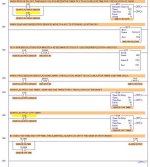hola a todos. here in trouble, hope you can help me.
i was asked to monitor t speed (rpm) of an axis. i have a pulse counter, and i have inductive sensor.. until that point everythings ok. t problem is that i dont have any cogwheel or protuberance to generate t pulses. i have seen some cogwheels which are made of 2 halfs which couple each other arround the axis and that way you have a cogwheel mounted on that axis. that is what i want to do but..
i have not found those cogwheels anywhere (here in town, on the web..) do i have to look for a CNC guy to do it or is there any commercial brand for these?
thanks for your help.
i was asked to monitor t speed (rpm) of an axis. i have a pulse counter, and i have inductive sensor.. until that point everythings ok. t problem is that i dont have any cogwheel or protuberance to generate t pulses. i have seen some cogwheels which are made of 2 halfs which couple each other arround the axis and that way you have a cogwheel mounted on that axis. that is what i want to do but..
i have not found those cogwheels anywhere (here in town, on the web..) do i have to look for a CNC guy to do it or is there any commercial brand for these?
thanks for your help.




